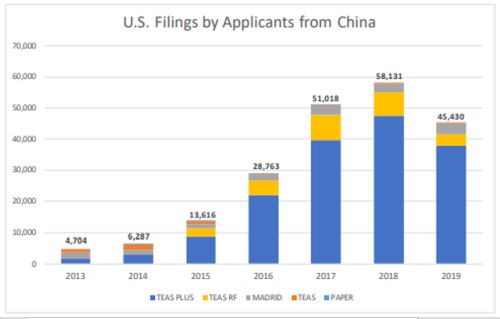In Tuesday's post, we helped you diagnose and address the misuse of your brand as part of a website's URL address. We hope this was useful. Recently, because of some desperation to sell low-quality goods, there has also been a dramatic increase in the misuse of leading brand names to sell infringing and/or counterfeit goods. The brand names are often used as part of a longer semi-descriptive name of a product on an online retailer site. We have also observed these brand violations on fully structured websites and in social media ads that draw to these pages. As part of these websites, your brand could be used somewhat descriptively in the title, in part of the product description text, in strangely frequent occurrences in the reviews, or simply in a comparison. Use of your mark, sprinkled on webpages, helps internet search engines find this abuser's page, and these uses are most often illegal.
The USPTO Public Advisory Committee Meeting presentation in July of 2019 showed that China alone was at the heart of more than half of foreign filings of brands because it clearly is the source for most lower priced substitute goods: 1

Foreign parties, while unable to secure rights over your mark, often use a "random store brand" as an online storefront. The U.S. Trademark Office has recently changed its rules to force foreign actors to offer their own contact information, email information, and the full contact information for a U.S. trademark attorney. The same way the WhoIs record helped identify relevant contacts for URLs (e.g., the domain owner, registrar, and host), this information is helpful to locate your infringer.
- Visit The USPTO Website
The USPTO website offers a trademark search tool called TESS. In it, you can search the name of the "random store brand" that misuses your own brand. This will allow you to find helpful contact information (e.g. the owner's name and address and their attorney's e-mail address and phone number). The information you seek is under a blue tab called "TSDR" on the top of the page for the trademark you have searched.
- Report To The Retailer When One Is Present
Retailers abhor infringement; their Terms and Conditions always make it clear that such brand infringement has no place on their website. Every large retailer website today offers tools to help report misuses of trademarks. These resources are often found in the bottom portion of the website under "Report an Intellectual Property Violation." To file a report, you will need to have the number on your certificate of registration on hand and often a PDF copy of the issued certificate.
Retailers may also provide resources for reporting counterfeit goods. Counterfeiting differs from simple trademark infringement in that counterfeiters pretend their goods are your legitimate goods. Counterfeiters will confuse buyers to a point where they believe the product is in fact yours. On the other hand, a simple trademark infringer will often just misuse your brand to their benefit (e.g. by implying a relationship with your trusted brand). For instance, a new company might use your trademarked slogan in advertising its similar product to lure customers in, which would infringe your trademark but not necessarily make their products counterfeits. However, if the new company sold a product that appeared to actually be yours but was not made or authorized by you, that product would be a counterfeit good.
- Social Media Ads
In today's social media world, product ads are often posted on popular social media websites, and with a single click these ads can redirect to standalone websites outside of the jurisdiction. Even if the standalone website does not use your mark, it is illegal to draw in customers by using your protected word or expression in the ad. For example, using something like "the latest car named X here, much better than the famous Y and Z brands sold for 200% more!" is not fair use or descriptive and violates state trade laws and trademark law even if your brand is not registered.
Social media platforms are now very good at offering tools for reporting illegal ad posts. Often, they are found in the upper right corner of the ad under the three little dots. These tools are intuitive but require a long process in which you will again be asked to input your trademark registration number, full contact information, and the type of violation encountered. Once again, all counterfeits are also trademark violations, but not all trademark violations qualify as counterfeit. To be on the safe side, you can report misuse of your brand as a trademark violation and simply place a note in the remarks that you believe it also is a counterfeit.
For further specifics on these issues, please do not hesitate to contact the authors.
Footnotes
1. USPTO Public Advisory Committee Meeting, July 2019, available at: https://www.uspto.gov/sites/default/files/documents/TPAC_JULY2019-Quarterly-Meeting.pdf
Disclaimer: This Alert has been prepared and published for informational purposes only and is not offered, nor should be construed, as legal advice. For more information, please see the firm's full disclaimer.
